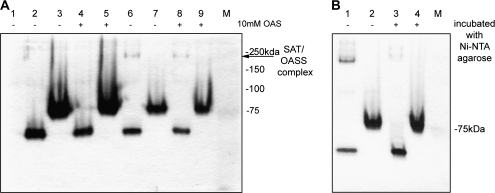Fig. 10.
Detection of a cysteine synthase complex in yeasts with co-expressions of SpOASS or OsCAS with WtSAT. In-gel CAS activity assay (A) was conducted on 100 μg crude protein from yeast transformants with pYES2 HIS–WtSAT (lane 1), pYES3 SpOASS–MYC (lanes 2 and 4), pYES3 OsCAS–MYC (lanes 3 and 5), co-expression of pYES2 HIS–WtSAT and pYES3 SpOASS–MYC (lanes 6 and 8), and co-expression of pYES2 HIS–WtSAT and pYES3 OsCAS–MYC (lanes 7 and 9). A ‘+’ sign represents an addition of OAS prior to loading and an arrow indicates a putative cysteine synthase complex. To demonstrate further that SAT is a component in this putative cysteine synthase complex, an in-gel CAS activity assay (B) was conducted on 100 μg crude protein (lanes 1 and 2) and protein pre-incubated with nickel agarose (lanes 3 and 4) from yeast transformant with co-expression of pYES2 HIS–WtSAT and pYES3 SpOASS–MYC (lanes 1 and 3)or co-expression of pYES2 HIS–WtSAT and pYES3 OsCAS–MYC (lanes 2 and 4). Pre-incubation extracts from yeast co-expressing SpOASS and WtSAT with nickel agarose would remove this additional CAS-stained band (lanes 1 and 3) and this demonstrated the interaction between SpOASS to WtSAT. SAT-specific activities from yeast transformants with co-expression of pYES2 HIS–WtSAT and either pYES3 SpOASS–MYC or pYES3 OsCAS–MYC were 86.32 μmol 5-thio-2-nitrobenzoate min−1 mg−1 protein and 74.00 μmol 5-thio-2-nitrobenzoate min−1 mg−1 protein, respectively, following the spectrophotometric assay from Bonner et al. (2005).

